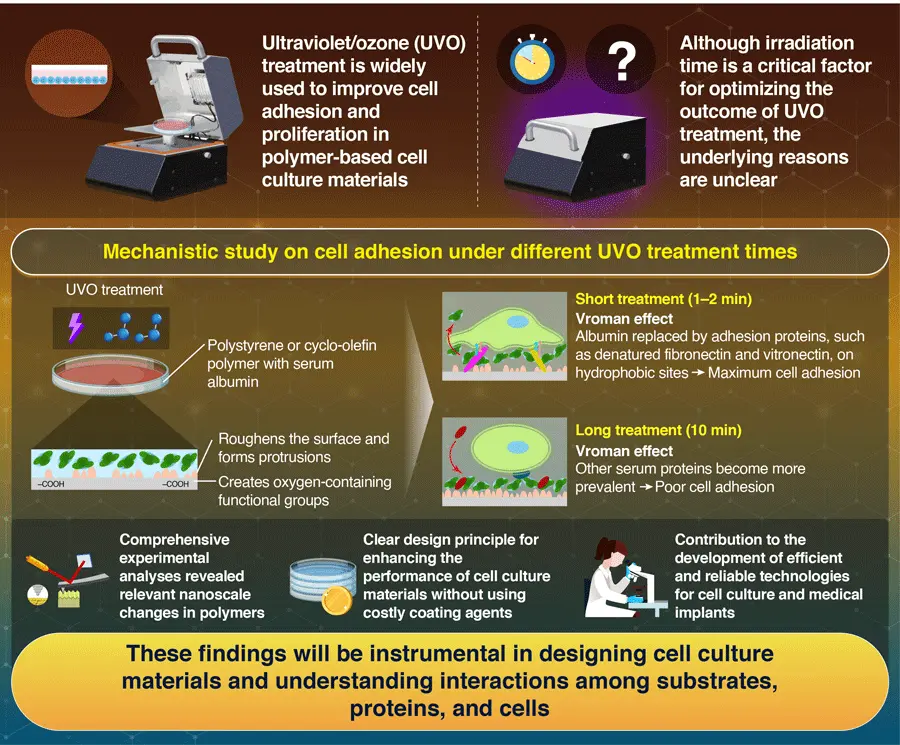Short ultraviolet/ozone (UVO) treatment optimizes cell adhesion on plastic culture substrates by selectively enriching adhesion proteins, as reported by researchers from Institute of Science Tokyo. Their latest study explains the underlying reason why there is an optimal UVO treatment time, with the optimal surface condition arising when the ability to selectively adsorb and immobilize key adhesion proteins is maximized. This study paves the way for the design of polymeric materials used in medical research.
Understanding the Mechanisms of Cell Adhesion on Plastic Cell Culture Materials

Most advancements in regenerative medicine and drug discovery hinge on our ability to reliably grow cells in the lab. One of the most common tools for this is the plastic Petri dish, a simple yet essential platform where cells are placed, fed nutrients, and encouraged to grow. When working with these dishes or similar containers, ensuring optimal cell adhesion is essential, as cells must firmly stick to the dish surface to thrive.
To increase cell adhesion, plastics are usually treated with methods like ultraviolet/ozone (UVO) exposure, which alters various surface properties to enhance cell adhesion. However, scientists have long noticed that there is a "sweet spot" for UVO treatment, as both too little and too much UVO leave cells unable to attach well. What determines the optimal treatment time and how optimal adhesion occurs has remained an open question-until now.
In a recent study, a research team led by Associate Professor Tomohiro Hayashi from the School of Materials and Chemical Technology at Institute of Science Tokyo (Science Tokyo), Japan, solved this puzzle. Their work, which was published online in the journal Langmuir on October 22, 2025, thoroughly investigated the physicochemical properties of polymer surfaces and the dynamics of protein adsorption before and after UVO treatment, explaining precisely why it enhances cell adhesion.
The researchers used a combination of advanced analysis techniques, including X-ray photoelectron spectroscopy and atomic force microscopy, to characterize the changes caused by UVO treatment in surfaces made from polystyrene and cyclic-olefin polymer. At the molecular level, they also carefully monitored the adsorption, composition, and exchange of serum proteins that attach to the polymer surfaces-these are the materials that actually create an interface with the cultured cells.
The study results revealed that surface properties, such as increased hydrophilicity (water affinity) and hydrophobicity (water repellency) alone, do not account for the optimal adhesion that occurs under short UVO treatment times. Instead, this optimal adhesion is directly correlated with the selective enrichment and immobilization of specific adhesion proteins on the surface, such as fibronectin and vitronectin, driven by a protein-exchange process known as the Vroman effect.
On untreated hydrophobic surfaces, non-adhesive proteins such as albumin stick rigidly, blocking the attachment of adhesion proteins. A short UVO treatment creates a surface with a mix of slightly hydrophilic and hydrophobic regions. This promotes the replacement of albumin with adhesion proteins, which are then securely trapped on the remaining hydrophobic patches in a way that cells can bind to.
Conversely, excessive UVO treatment removes too many hydrophobic patches, causing albumin to be replaced by a more generalized mix of serum proteins. This ultimately reduces the concentration of adhesion proteins, leading to poor cell adhesion. "These findings offer a scientific basis for the optimization of surface treatment techniques that have previously been developed through a trial-and-error approach," explains Hayashi.
Overall, this work has important implications at the crossroads between materials science and biomedical research. "Our study provides a clear design principle for maximizing the performance of inexpensive materials without using costly coating agents in cell culture technologies, which are indispensable for regenerative medicine and drug discovery," concludes Hayashi. "Therefore, we expect these efforts to contribute to the development of more efficient and reliable cell culture devices and medical implant materials."
Reference
- Authors:
- Riko Kaizu1, Seiichiro Takahashi2, Kenichi Hirose2, Kenji Hatakeyama2, Glenn Villena Latag1, Ayano Nomura1, Hiroyuki Tahara1, and Tomohiro Hayashi1,*
- Title:
- UV/Ozone Treatment of Polymer Surfaces to Enhance Cell Adhesion: The Mechanism and Guidelines for Optimization
- Journal:
- Langmuir
- Affiliations:
- 1Department of Materials Science and Engineering, School of Materials and Chemical Technology, Institute of Science Tokyo, Japan
2Ushio Inc., Japan






